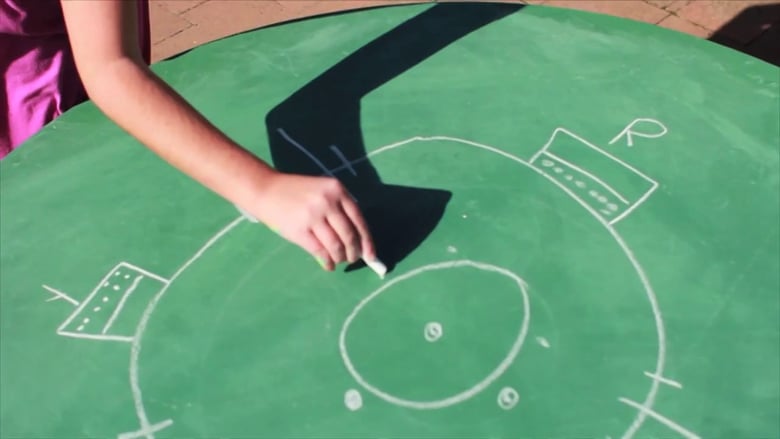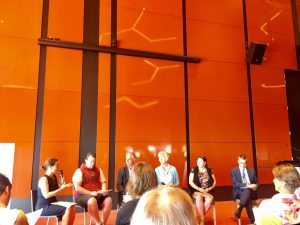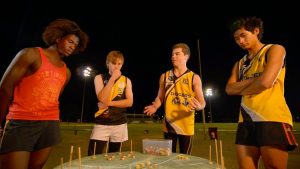Coming together to think. It’s an important time. Say it’s your family and you own a property in common, and now it looks like time to sell. Say it’s your community and there’s a planning proposal that’s going to affect the amenity of a special place. Say it’s your city, and the practices of the elected representatives has gone so far downhill that the state government has stepped in. There are commissioners running the city. But that’s a short-term solution. How would citizens respond to various options for the governance in the long-term? The Geelong Citizens’ Jury on electoral reform saw citizens come together to think.
The Geelong Citizens’ Jury
One Saturday in March I spent the morning at the splendid Geelong Library. The Minister for Local Government, the Hon Natalie Hutchins MP, had made a date to respond to the Jury’s recommendations.
At least a hundred people turned out for the event, many of them interested citizens. After a stunning welcome to country, the Minister highlighted the transparency of the process, in which the jury took place alongside submissions from ‘the people of Geelong’ and online surveys. In other words the government had undertaken a hybrid process. She gave a warm thanks to the jury, highlighting their good sense and commitment, and said that she supported the main ‘practical’ recommendations to go forward to legislation. They had been taken to cabinet. ‘People power shone brightly through this process,’ she said.
There were three jurors as panellists who told of their experience. ‘Discussion without acrimony, one said, ‘it was a democratic experience’. The other woman said: ‘I was proud to be part of the human race, and what democracy can be’. Another juror was clear that the process had taken him outside his comfort zone.
The Minister spoke of the jury as ‘a catalyst for community leadership’. Ideally some of the underpinnings of this might be:
- learning new skills in collaboration and negotiation
- learning about policy and governance
- learning to influence elected representatives
- becoming spokespeople or ambassadors of positive governance
- an understanding of the commitment required in policy decision-making
Yet could it be that many of the Geelong jurors were public-minded to start with? Are many of us public minded, but we don’t get the forum or avenue through which to express our best thinking?
Three teams (2013)
City of Moreland’s Counihan Gallery’s current exhibition is Leather Poisoning.
A footie exhibition. Did you know that having the ball for too long constitutes leather poisoning? New to me!
Gabrielle De Vietri’s Three Teams, ‘a highly imaginative’ submission to the Basil Sellers Art Prize in 2014 is documented on dual channel video and runs for 30 minutes. It’s a captivating exercise story of deliberation. De Vietri put the question to the Horsham community ‘Do there have to be two teams on the field in a footie match? Why not three?’
I was amazed by the similarity this project revealed with a citizens’ jury.
- Almost everyone approached to participate responded with scepticism. I could see the same looks on faces. ‘It won’t be worth it’. ‘It’s going to be a waste of time.’ ‘Leave me alone with my regular AFL game. What ifs are unnecessary.’
- A very diverse range of participants became highly involved. In a citizens’ jury, in group, small group and paired activities, jurors investigate ‘what ifs’. In ‘Three Teams’ the participants worked with models, trying out positions of goal posts, direction of play, shape of oval, number of umpires, what would constitute being offside. Plenty of arguments, uncertainties and interest in points of difference.
- ‘The people’s voice’ grew strong and authoritative with the community creating the rules of the game and organising an on-field event. This parallels the jury experience where the jury comes to recommendations.
Both the Geelong Citizens’ Jury and Three Teams demonstrated great community engagement. You could see them as social and behavioural experiments. They were highly imaginative. People came together to think. Their communities were enriched by their commitment to ‘what if?’
What if?
As you may be aware I’m building a small business alongside my work in facilitation and community engagement Kinship Ritual. The new work is driven by a ‘what if?’ What if there wasn’t only one way to think about funerals and end of life experience? What if we looked at options, held facilitated conversations, and curated what we want for this very important time?



